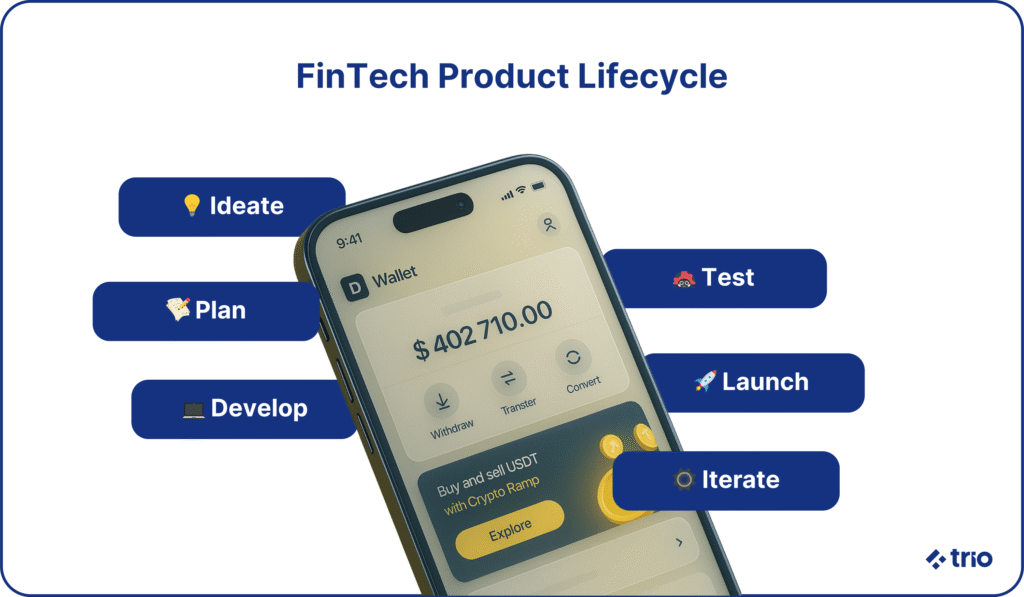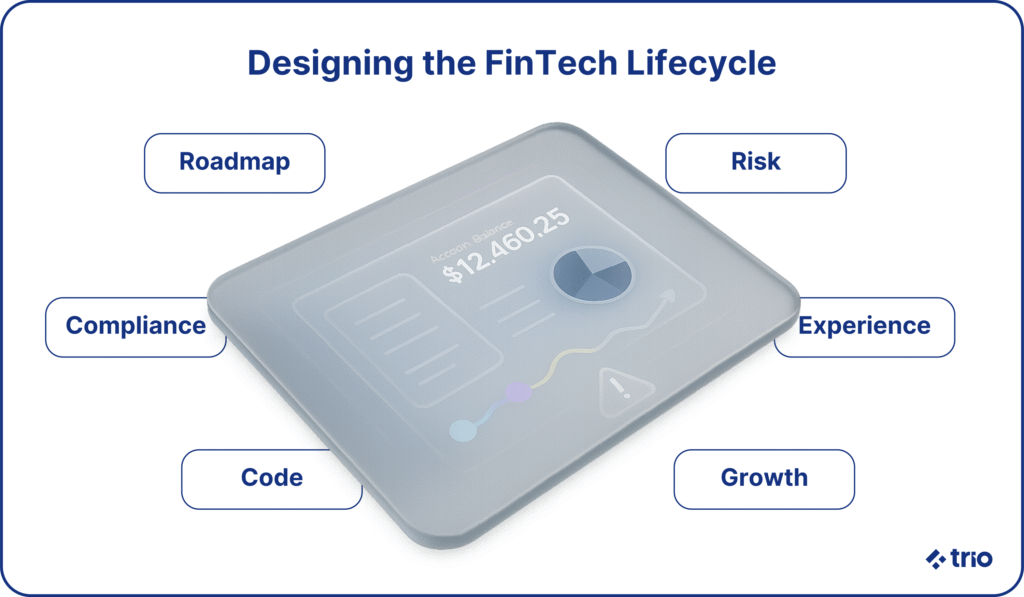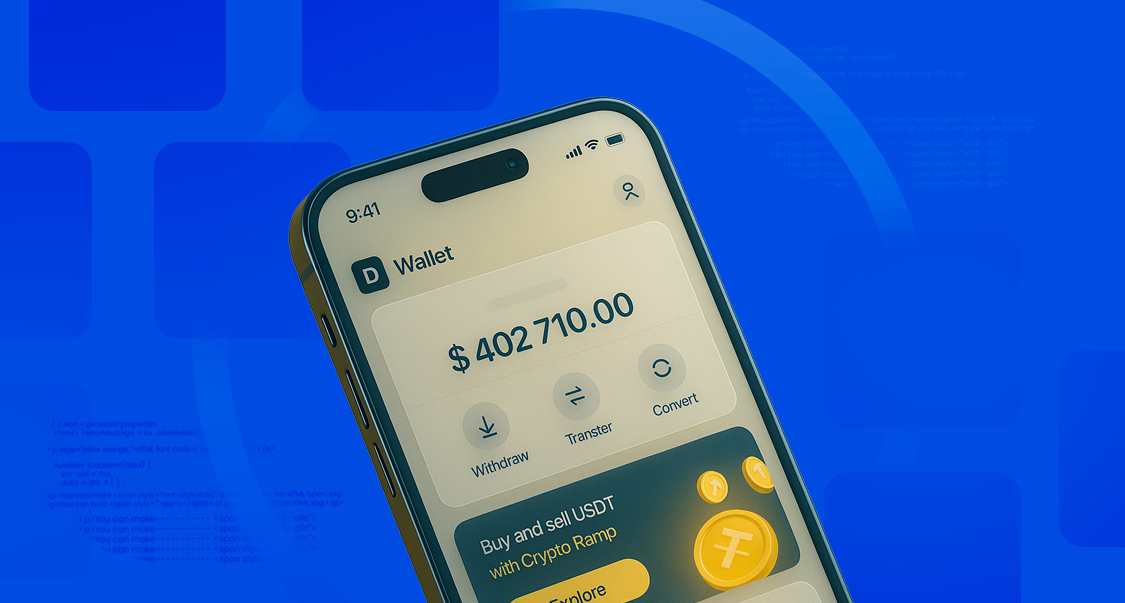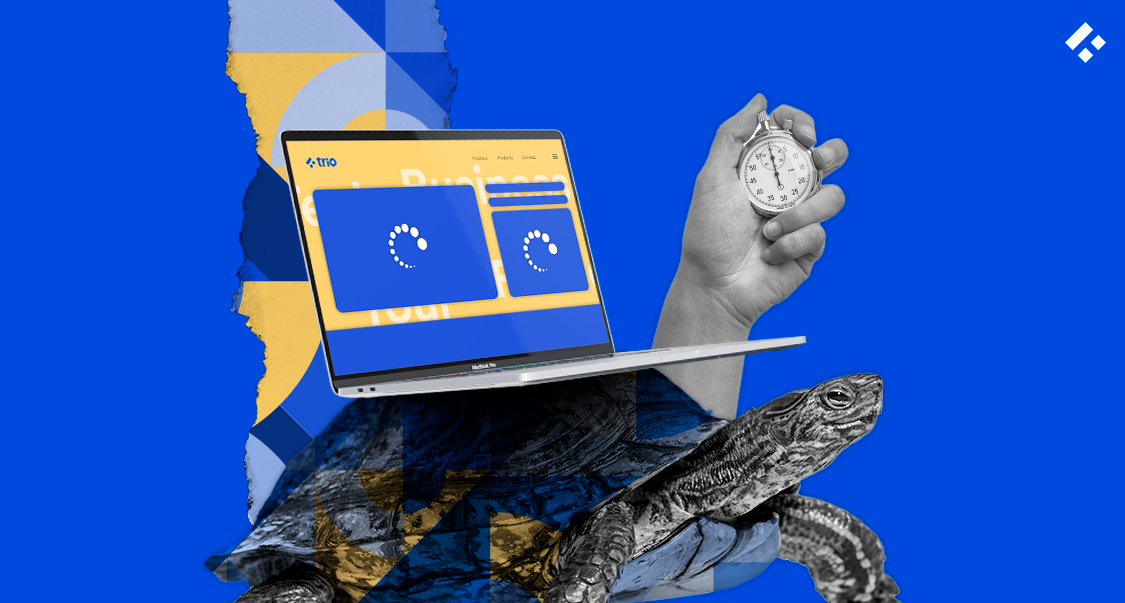It is incredibly important to understand the fintech product lifecycle, whether you’re the founder of a fintech startup, a product manager, a stakeholder, or even just a developer, so that you can understand the different challenges you may encounter and so that you can prepare to adapt to a changing fintech industry.
If you fail to make these changes or prepare for potential issues in each stage of the development and marketing process, you risk losing money throughout your workflow and restricting your success to a very brief period after you deploy your product.
Let’s walk through each stage of the fintech software development lifecycle so that you have all the knowledge you need to set yourself up for success.
If you are thinking of creating fintech software solutions of your own, you are in the right place. At Trio, we employ the top 1% of software developers, many of whom are specialists in financial technology and have experience working on platforms that provide financial services while taking nuances like regulatory compliance and industry standards for security into account.
These developers not only allow us to provide fintech companies with high-quality software development services through outsourcing and staff augmentation, but also allow us to provide you with practical knowledge that may be crucial in the fintech industry.

What is a FinTech Product Lifecycle?
Before we can understand the different phases, you first need to have a good understanding of the fintech product lifecycle, also sometimes referred to as the fintech software development life cycle.
In short, it is the entire process, from beginning to end, of creating your product: from the idea through all of the software development, the market launch and growth stage, and finally the decline stage or continuous innovation and reinvention.
While product development in other technology sectors can look very similar, fintech solutions are unique in that they need to protect sensitive financial data. This means that there are a bunch of regulations that need to be taken into account in part of the lifecycle.
These regulations and the impact of user trust add additional factors to consider in risk management.
Phases of the FinTech Product Lifecycle
Let’s look at what you can expect in each phase, the tools you might want to use, and the challenges and opportunities that might emerge in the fintech landscape specifically.
1. Ideation & Research
This is the first part of any product development. It’s the ‘R’ in R&D. You need to figure out where there’s a gap in the market or something that can be improved on, and then create a clear roadmap for how you are going to proceed.
Your market research should focus on everything from overarching market trends to detailed competitive analysis. Don’t forget to look into any regulatory requirements so that you can ensure you are compliant from the start.
Many companies decide to interview their prospective customer base to validate their ideas. This helps confirm your preliminary plan and also makes it easier to get stakeholders on board. We like to use tools like Figma to increase ideation and iteration speeds and give users more information for this initial feedback.
You could also use tools like market research platforms, competitor tracking tools, and regulatory intelligence databases. The more information you get, the easier it will be to make data-driven decisions.
2. Product Incubation & MVP Development
Once you have your idea and confirmation through user feedback and market data that your product is needed, you can start building a minimum viable product (MVP) with all of the core components that will solve your target problem.
This simple version of your product is faster to develop and lets you get to testing and later stages faster.
In order to create this MVP, you need to decide on the tech stack you want to use. Make sure that you focus on prioritizing robust security measures to protect your clients even in the most basic version of your app. Scalability should also play a major role in your decisions.
We like to use technologies like React.js or Python, but there are a myriad of options out there. Open banking APIs, cloud-native architectures, and blockchain frameworks can also help you enhance transparency and compliance with industry standards for security protocols.
A great way to ensure success during these early stages is to maintain an agile development team (use tools like Scrum or Kanban), create KPIs, and emphasize continuous testing of your feature functionality as well as user experience. Don’t forget integration testing, as each feature can work well on its own, but still not work in the context of the rest of your app.
Penetration testing is a useful tool, too, as it ensures you are able to protect user data. Keeping good records of any tests related to security and regulations is one of the best practices we recommend you implement, as you may be required to provide evidence of regular security audits at a later date.
Above all, make sure your fintech app is compliant with frameworks like PCI DSS for financial transactions and GDPR for data privacy. You want to set yourself up for success from early on so you can start building trust with your users, even in the most basic form of your app.
3. Growth & Market Penetration
Once you have your MVP ready, you enter what can be called the fintech growth phase. In this phase, you launch to everyone. This means you’ll need a go-to-market plan, ensure your app is scalable for when your user base increases, and you’ll need a way to gather customer feedback.
For a lot of fintechs, this might not necessarily be launching a mobile app on an app store. Instead, it could involve a strategic partnership with the banking industry to provide a new service to their clients or an improvement to their legacy banking systems.
Remember to keep an open mind, as these partnerships can not only help you with your marketing efforts but can also be instrumental in navigating the complex regulatory landscape of various regions.
4. Maturity & Optimization
As your products moved into the maturity stage, you started shifting your goals from getting your basic product out there to operational efficiency, continued regulatory compliance, ensuring robust security measures that evolve with threats, and improving your user-friendly interface to retain your users.
Usually, this will involve continued research as you include new features and UI/UX improvements as you gather data.
There are a couple of automated monitoring and performance tools you can use, like Datadog, or you can create your own monitoring software.
There are also a bunch of RegTech platforms you can use to ensure you are compliant with regulations. ComplyAdvantage and Alloy are probably the most popular examples.
5. Decline, Reinvention, or Exit
There comes a point in every fintech product where growth starts to slow. Getting new customers becomes more expensive as you’ll either have to add new features to your app that few will use, or pay additional for marketing.
Some things you can look out for that may indicate this decline phase include increased churn, stagnant user engagement, and even increased pressure from your competitors.
So, what do you do?
Often, you will either have to sunset a product, pivot to a new solution, or look at opportunities for mergers, acquisitions, and IPOs.
This phase is so common in fintech products that financial modeling tools like Finmark and Pry help fintech leaders make decisions on the feasibility of pivots, which exist by taking factors like churn rates, revenue concentration, and support ticket volume into account.
The important thing is to make sure you keep users updated with what is going on. We also recommend that you get legal support to ensure you sunset or merge within regulations.
Lifecycle Management Teams and Their Roles
Project management throughout the lifecycle of your fintech product requires communication in cross-functional teams.
You’ll need a product development team that can manage things like backlog, sprint cycles, prototyping, and user testing.
Then you’ll need compliance experts who can keep an eye on your regulatory compliance through each step, even as you expand to different regions where regulations might be very different. Alongside these, risk managers who specialize in fintech can help you identify and mitigate risks: technical, operational, and financial.
You’ll also need marketing and growth teams to help you create campaigns, develop customer acquisition strategies, and even measure your ROI.
This is a sizeable team already, and then you haven’t even gotten your DevOps and technology specialists who can help you create your product and implement monitoring tools. On your development team, you’ll want people who can help you ensure security, scalability, and performance.
They will need to work well with business intelligence and customer experience teams to bring actionable insights to life.

Regulatory & Security Considerations Throughout the Lifecycle
The regulations and security considerations that you need to take into account will vary depending on the region in which you are marketing your product. For most companies conducting business in the US and Europe, you’ll have to account for laws such as PSD2, GDPR, CCPA, and anti-money laundering (AML) regulations.
In most cases, these laws will require you to implement data privacy and protection techniques. These could include
- Secure authentication
- Encryption
- Fraud protection tools.
There are two ways in which you can implement these tools. You could partner with a RegTech company, as mentioned above, or you could partner with developers who can help you build custom tools for your solution. These could include automated tools for auditing, onboarding, and compliance checks.
If you have a smaller, simpler app, going with a RegTech company might be easiest. But if you have a large app with complex integration considerations, you might need a developer to help you implement the RegTech solution, or you may want to consider developing your own solution.
In either case, Trio’s experienced developers can assist you with our staff augmentation and outsourcing models, providing cost-effective solutions that you can trust.
How AI, Blockchain & Automation Are Transforming Fintech Products
AI, blockchain, and automation are affecting a variety of sectors. Fintech is not exempt from these industry trends.
Use of AI for personalization has now become a user expectation, while many fintech companies are also using it to automate underwriting, credit scoring, and fraud detection. You’ll need to keep up with these expectations and automation to ensure you don’t fall behind.
Blockchain is also facilitating decentralized finance (DeFi), which is becoming more popular thanks to an increased emphasis on transparency and data integrity. Automation tools also play a role in compliance and operations, like reporting, which we have already mentioned.
The goal of these technologies is always to improve internal efficiency, but also to improve the overall trustworthiness, customer service, product design, and regulatory compliance at each phase of the product lifecycle.
Sustainable and ESG-Compliant FinTech Products
Sustainability and ethics are becoming more important. Users are educating themselves and placing more value on ESG (Environmental, Social, and Governance) principles.
How can fintech companies integrate these principles into their products?
A focus on financial inclusion, supporting green investments, and ensuring fair prices is a good place to start. Financial inclusion, for example, is relatively simple to promote with the assistance of new technologies like IoT, and can be used by your sales team as part of their marketing approach.
Once you have the basics down, you can focus on sustainability through transparent governance, responsible data sourcing, and additional financial accessibility innovations.
Remember, ESG compliance is more than just about your moral imperative; it helps you differentiate yourself from competitors. So, make sure people know about it. Not only will this assist your sales, but it may even attract institutional capital or regulatory leeway.
Real-World Case Studies of FinTech Product Lifecycles
There are many different fintech product lifecycles you could look at in order to get an idea of what you can expect.
Monzo, a British online bank, started as an MVP with only a prepaid card. Later, features like local and international payments were added until it turned into a full-blown bank. A lot of its success could be attributed to their user-focused approach with a focus on not only ease of use but also security!
Klarna is another great example. The company is now one of the most well-known names in fintech. A large part of their success can be attributed to how they meet user demands, indicating a successful research phase of their lifecycle. They provide Buy Now Pay Later (BNPL) services to consumers who are perhaps underserved in the credit industry.
They have been able to partner with many existing merchants and leverage proprietary, AI-based algorithms in the maturation and optimization phases of their product lifecycle to improve their risk management and overall product.

Ensuring Success Throughout The Fintech Product Lifecycle
The best way for you to ensure success throughout the fintech product lifecycle is to get experienced developers on your team who are familiar with the nature of financial transactions and have worked on similar projects before.
Trio is able to provide these developers, taking over entire sections of your project, or adding developers to your existing team. All of this means that you have someone available to comment on regulatory compliance or any additional features they feel you may be missing.
If you are interested in connecting with experienced fintech developers for any part of your project, reach out to us for a free consultation! We can connect you with the right developers from regions like Latin America or Africa within as little as 24 hours.






